Navigation:
EMS Outputs > Acknowledging Alarms >> Acknowledge Alarms from the Live View
Acknowledging Alarms from the Live View
It is also possible to acknowledge and Alarm from the Live View (a Sensor in an alarm condition will be appear in red in the Sensors listing).
Acknowledging Alarms from the Live View
1.In the Graphical Overview/ Dashboard, click on the View live data icon ![]() on the required Site's Site Icon to display the Live View window for the selected Site.
on the required Site's Site Icon to display the Live View window for the selected Site.
| Note: | By default, the Live View window displays a list of the Sensors for the Zone at the top of the drop-down list. |
2.From the View Data drop-down menu, select the required Zone containing one or more Sensors in alarm. See Figure 1245 below:
Figure 1245
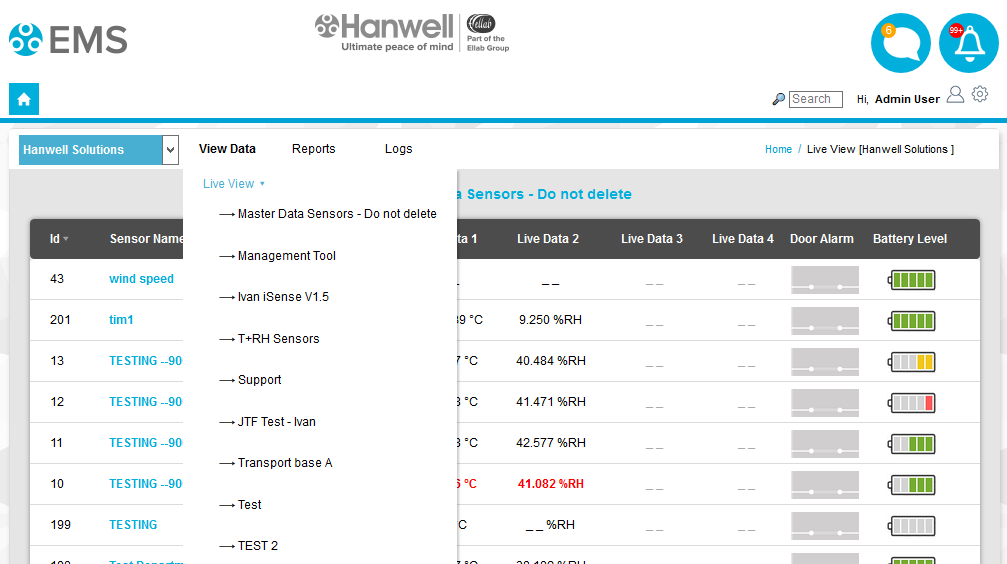
•The Live View [Site name] window is displayed showing a list of the selected Zone's Sensors. See Figure 1246 below:
Figure 1246
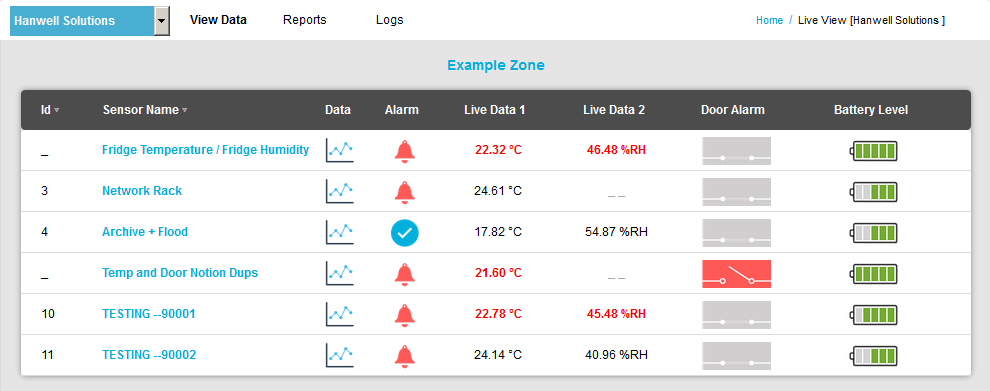
• A Sensor with one or more unacknowledged alarms will be indicated by a red alarm symbol ![]() in the window's Alarm column. The Sensor's Live Data values will also be displayed in red.
in the window's Alarm column. The Sensor's Live Data values will also be displayed in red.
•A Sensor with one or more acknowledged alarms will be indicated by an amber symbol ![]() in the window's Alarm column.
in the window's Alarm column.
•A Sensor with no alarms will be indicated by a blue 'tick' symbol ![]() in the window's Alarm column.
in the window's Alarm column.
3.Clicking on a Sensor's red alarm symbol ![]() (unacknowledged alarms) displays the Acknowledging Alarm for <Sensor Name> field in a browser window. See Figure 1247 below:
(unacknowledged alarms) displays the Acknowledging Alarm for <Sensor Name> field in a browser window. See Figure 1247 below:
Figure 1247
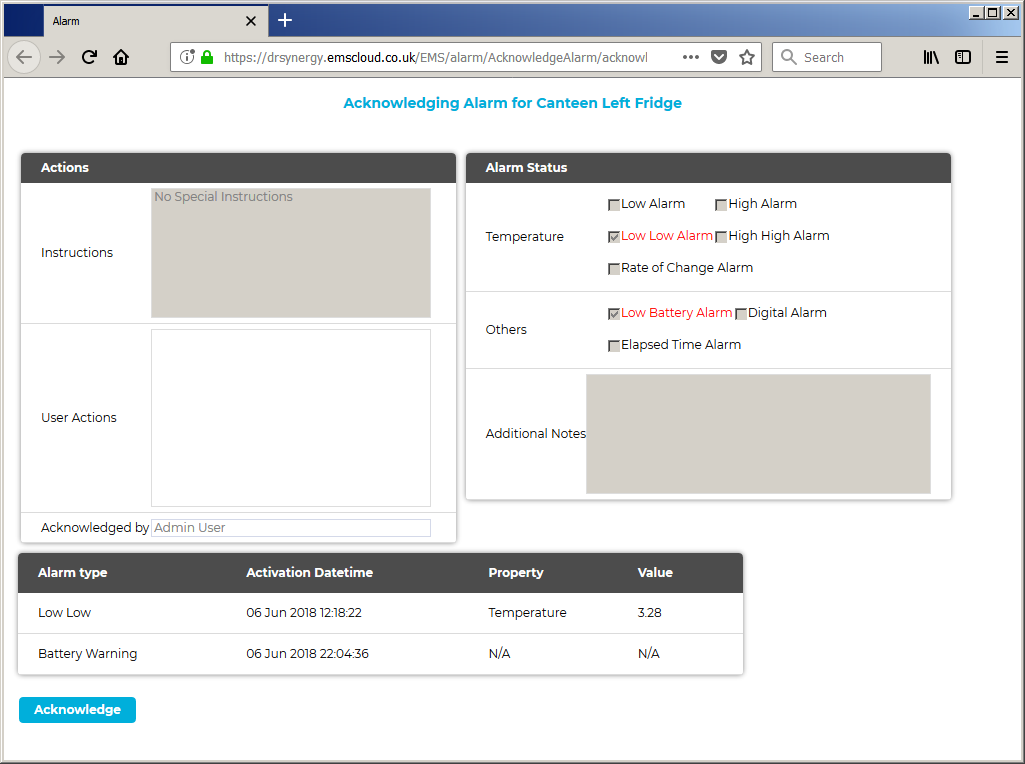
•The active alarm or alarms will be highlighted in Red and its adjacent box will be ticked.
➢In this example the active alarms are the Low Low Alarm for temperature and the Low Battery Alarm.
•If any instructions were added when the alarm parameters were set, these would appear in the Instructions dialog box.
➢For more information on instructions see the Notes section.
4.In the User Actions dialog box, enter a note that is relevant to the alarm.
| Note: | You cannot acknowledge the alarm without entering a note into this dialog box. |
5.When happy, click on the Acknowledge button.
•You will be returned to the Live View [Site name] window. See Figure 1246 above.
•The acknowledged Sensor's list entry and its data value will now be highlighted in Amber to indicate that its alarm is in an Acknowledged state. See Figure 1248 below:
Figure 1248
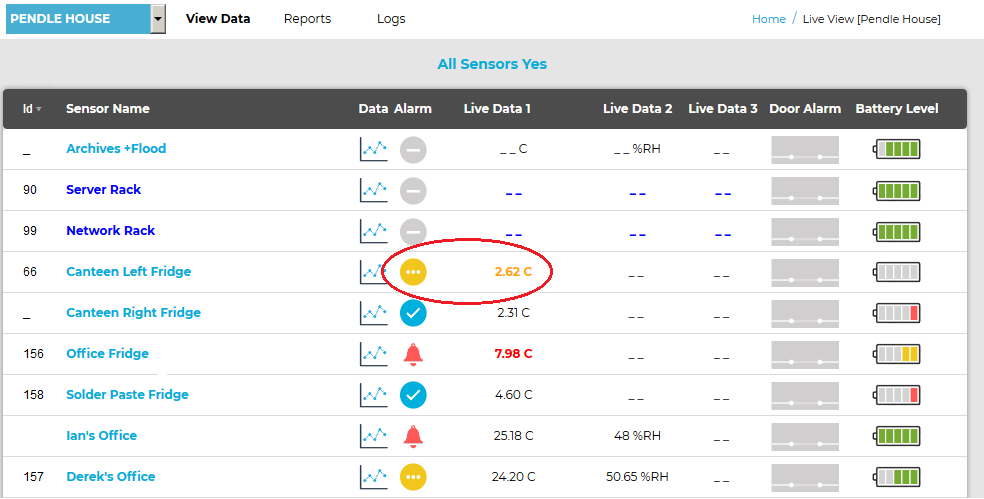
6.Clicking on the amber alarm symbol ![]() (Acknowledged Alarms) displays the Reset Alarm for <Sensor Name> [Alarm Type: <...>] field in a browser window. See Figure 1249 below:
(Acknowledged Alarms) displays the Reset Alarm for <Sensor Name> [Alarm Type: <...>] field in a browser window. See Figure 1249 below:
Figure 1249
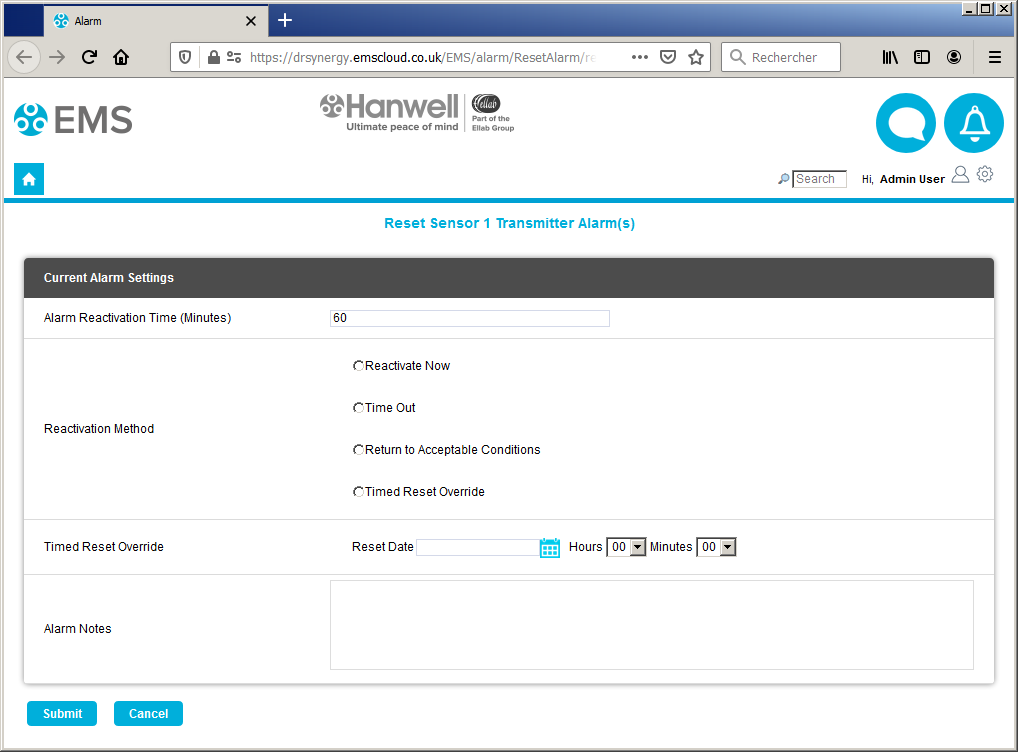
| Note: | For a multiple channel Sensor/Transmitter, clicking on the amber alarm symbol Figure 1250  Clicking on the required channel's amber alarm symbol in the popup displays the Reset Alarm for <Sensor Name> [Alarm Type: <...>] field for the selected channel alarm in a browser window. |
•The Reset Alarm for <Sensor Name> [Alarm Type: <...>] window allows access to the following functionality:
Current Alarm Settings
➢The Current Alarm Settings are displayed at the top of the window.
➢If the logged in User has the Permissions these limits can be adjusted at this stage.
Caution: Any changes made here will be populated back to the main database.
Reactivation Method
There are four methods available to reset the Alarm:
➢Reactivate Now
If Reactivate Now is selected, as soon as you select Submit the Alarm will be acknowledged.
oIf the Alarm condition still exists the status will return to Red and a new Alarm will be generated on the System.
oIf the Alarm conditions have returned to normal the Amber Alarm icon will be removed from the list.
When selecting Reactivate Now a default message “Reactivate Now was selected for this Alarm” will be entered into the Alarm Notes text box. This can be added to or overwritten.
➢Time Out
If Time Out is selected, as soon as you select Submit, the Alarm will be acknowledged after the time delay entered into the Alarm Reactivation Time (Minutes): dialog box.
oIf the Alarm condition still exists after the Time Out period the status will return to Red and a new Alarm will be generated on the System.
oIf the Alarm conditions have returned to normal the Amber Alarm icon will be removed from the list.
When selecting Time Out a default message “Time Out was selected for this Alarm” will be entered into the Alarm Notes dialog box. This can be added to or overwritten.
•Return to Acceptable Conditions
If Return to Acceptable Conditions is selected, as soon as you select Submit the Alarm will be acknowledged as soon as the conditions return to normal limits.
oThe Amber Alarm icon will remain until the conditions return to normal limits.
When selecting Return to Acceptable Conditions a default message “Return to Acceptable Conditions was selected for this Alarm” will be entered into the Alarm Notes text box. This can be added to or overwritten.
•Timed Reset Override
This feature allows you to defer the Alarm reset until a future date and time.
➢To enter the required future date, select the required date from the calendar displayed by clicking on the Calendar icon.
oThe selected date will be entered in the dialog box next to Reset Date.
➢To enter the required time on the future date, select the time of day from the Hours and Minutes drop-down menus.
This feature could be used if, for example, the air conditioning in a room or space failed and it was going to take several days to get an engineer in to carry out repairs. In this case, setting a Timed Reset Override would prevent the inconvenience of the Alarms being continually activated until the engineer arrived to repair the System.
Using this feature requires you to manually enter a note into the Alarm Notes text box.
➢A suitable note for this example could be: “Engineer called to repair Humidifier unable to attend site before next Friday”
7.When happy with the details -
Either:
Click on the Submit button to save the changes and Complete the Alarm.
Or:
Click on the Cancel button to discard the changes.
